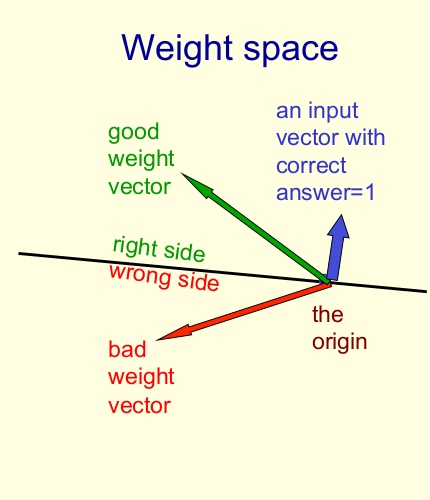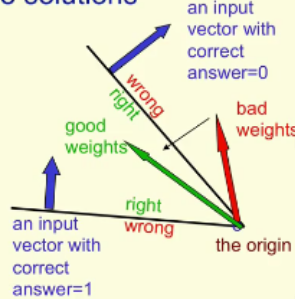Lecture 2c: A geometrical view of perceptrons
Warning!
- For non-mathematicians, this is going to be tougher than the previous material.
- You may have to spend a long time studying the next two parts.
- If you are not used to thinking about hyper-planes in high-dimensional spaces, now is the time to learn.
- To deal with hyper-planes in a 14-dimensional space, visualize a 3-D space and say “fourteen” to yourself very loudly. Everyone does it. :-)
- But remember that going from 13-D to 14-D creates as much extra complexity as going from 2-D to 3-D.
Geometry review
- A point (a.k.a. location) and an arrow from the origin to that point, are often used interchangeably.
- A hyperplane is the high-dimensional equivalent of a plane in 3-D.
- The scalar product or inner product between two vectors
- sum of element-wise products.
- The scalar product between two vectors that have an angle of less than 90 degrees between them is positive.
- For more than 90 degrees it’s negative.
Weight-space
- This space has one dimension per weight.
- A point in the space represents a particular setting of all the weights.
- Assuming that we have eliminated the threshold, each training case can be represented as a hyperplane through the origin.
- The weights must lie on one side of this hyper-plane to get the answer correct.
- Each training case defines a plane (shown as a black line)
- The plane goes through the origin and is perpendicular to the input vector.
- On one side of the plane the output is wrong because the scalar product of the weight vector with the input vector has the wrong sign.
The cone of feasible solutions
- To get all training cases right we need to find a point on the right side of all the planes.
- There may not be any such point!
- If there are any weight vectors that get the right answer for all cases, they lie in a hyper-cone with its apex at the origin.
- So the average of two good weight vectors is a good weight vector.
- The problem is convex.
- So the average of two good weight vectors is a good weight vector.
This is not a very good explanation - unless we also take a convex optimization course in which we define a hyperplane and a cone.
Reuse
CC SA BY-NC-ND
Citation
BibTeX citation:
@online{bochman2017,
author = {Bochman, Oren},
title = {Deep {Neural} {Networks} - {Notes} for Lecture 2c},
date = {2017-07-19},
url = {https://orenbochman.github.io/notes/dnn/dnn-02/l02c.html},
langid = {en}
}
For attribution, please cite this work as:
Bochman, Oren. 2017. “Deep Neural Networks - Notes for Lecture
2c.” July 19, 2017. https://orenbochman.github.io/notes/dnn/dnn-02/l02c.html.

